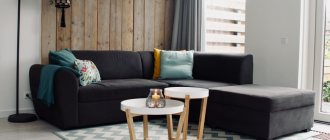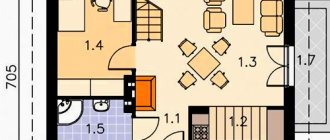If you dream of watching movies that will impress your guests, take care of high-quality sound. And it’s not just about the equipment, although this is also very important. Even more important is the placement of the home theater speakers.
To ensure sound reaches your audience's ears perfectly, first consider how it acts as a physical phenomenon. Only then will you understand the impact of the above-mentioned aspect of running your own cinema on the audience's experience.
Every sound is actually a wave. Depending on how loud and powerful the sound is, the waveform will have different properties, especially in terms of length and frequency. When a wave encounters an obstacle, it is refracted or reflected. In both cases, the sound is distorted, meaning that when it reaches your ears, it doesn't exactly match what the source sent.
In an ideal environment, the distance between the home theater speakers should be adjusted so that the sounds reach the viewer directly .
This situation can be found in professional cinema halls, which are ideally prepared to provide the best possible sound. In an apartment or house the situation is a little more complicated. When considering where to place your home theater speakers , consider all kinds of obstacles: furniture, windows and doors. The situation with soundproofing walls can also be a bit problematic, as it will create additional distortions in the sound waves.
With a woefully inadequate home theater setup, you'll end up with headaches and barely audible, blurry dialogue in movies.
Choosing the location of the subwoofer in the room by ear
This procedure is performed after connecting and configuring the entire system. Place the subwoofer in different places in the room, turn on a recording with good bass and listen while in the audience area. When the bass is most intelligible and not buzzing, this is the optimal dislocation for the subwoofer. Another method is called "from the reverse". The subwoofer is placed where the audience seats will be, and the installer begins to move on all fours along the walls of the room. As soon as you find an area where the bass will sound the clearest and most intelligible, you can place a subwoofer there. If there is only one in the system, pay attention first of all to the area next to one of the front speakers. The subwoofer should be 20-30 cm from the wall, but in a corner.
How to properly place home theater speakers indoors
The size of the room and its geometry are the main parameters that should be taken into account when installing a speaker system. The standard and most suitable option would be a rectangular room. In this case, you can place the TV or projector screen near a long wall. It is desirable that there are no protruding relief trim on the ceilings, which causes distortion of sound waves. The ideal room area for a home theater should exceed 35 m². It is important to maintain the optimal distance between the audience's seats and the front speakers.
Doors must be installed in the room. This allows you to avoid extraneous sounds and create a closed chain for sound distribution. Soft padding on the inside of the door will help prevent additional noise and vibration. When properly configured for a home theater, the device provides not only excellent playback quality, but also loud sound. That is why it is advisable to use soundproofing material to cover the walls.
It is important to know how to properly place your home theater speakers and maintain sound reflection. One thing to consider when placing equipment is that when it hits a surface, sound will be reflected at the angle of incidence. Some part will be absorbed, and the rest will pass through the existing obstacle. This achieves the famous surround sound effect. With constant reflection from the walls, the waves gradually begin to fade, become weaker and disappear. In the process of reflection from an obstacle, the signals reach the listener with a delay of several milliseconds. The result is an uneven, surround sound effect.
Type and placement of rear speakers
One of the fundamental rules for choosing acoustics is homogeneity. It is understood that all the main speakers of a multi-channel system (this does not apply to the subwoofer) must belong to the same series of the same manufacturer. However, installation conditions often make their own adjustments. It happens that it is not possible to place spectator seats (chairs or sofas) at a distance of at least one meter from the back wall. And if this is exactly the situation (which is undesirable), the only way to ensure more or less correct surround sound is to use wall-mounted speakers with shallow cabinets. They should be mounted at a height of approximately 2 meters from the floor and, if possible, oriented slightly towards the audience. Next, correction is made by the receiver settings. It also makes sense to use a high location of rear wall speakers if it is necessary to provide sound for seats in several rows. You can see clear examples of how such a scheme is implemented in any modern commercial cinema. If there are 2-3 seats and they are installed in one row, then bookshelf-type cabinet speakers on high stands or on wall brackets are perfect for sounding the rear channels. They should be located just above the spectators’ heads, at a distance of at least 1.5 m (preferably further) from them.
What is the ideal screen placement?
Ideally, the screen should be positioned directly opposite, centered at almost eye level from the primary viewing position. A deviation from the horizontal or vertical axis of 10-30 degrees does not greatly affect the quality, and modern screens have wide viewing angles, designed for viewing by a large group. Usually the room dictates the conditions, and therefore you need to think about the seating, choosing the furniture itself and its arrangement so as to eliminate neck pain and other discomfort during prolonged viewing.
Very often, this problem is caused by screens that are hung above fireplaces - they end up being located too high for most sofa models, which is why you have to lift your head up. However, if you most often look at the screen while lounging on the couch, this solution may be convenient. In this situation, you can even add a second row of high chairs located behind the main sofa near the bar or table, which is quite common in combined kitchens/living rooms.
If you're using a projector rather than a TV, the viewing angle may be more awkward. Find a place where you don't have to raise your head.
Should I choose 5.1 or 7.1?
This question is becoming less and less relevant, and with the advent of Blu-ray and HD DVD “in every home” it will completely lose relevance: for new formats 7.1 is the de facto standard. However, in some cases 5.1 is preferable. For example, in small rooms in which the rear speakers installed at an angle of 110 degrees will be located further from the viewers’ ears than the side and rear speakers in a 7.1 scheme. This means that the surround sound will be more voluminous due to better sound dispersion, despite the smaller number of channels in the system.
What are the best TV settings for watching fast-paced content like sports?
Your TV most likely has a "sports" mode, and I'd start there. The settings for this mode vary greatly from model to model. For example, edge enhancement works well on some devices, but on others it takes a few frames to get going. This is normal for feature films, but in sports broadcasts it is infuriating.
Many TVs can create intermediate frames using "predictive" algorithms, a process most commonly called frame interpolation. If your model knows how to create such frames well, then the broadcast will look less “crystalline” and rough. However, a “soap opera” effect can also result. Some TVs simulate the phosphor fading effect in these intermediate frames, familiar from CRT and plasma TVs, and it looks nice.
Furniture selection
When choosing furniture, the main factor is comfort.
In this matter, most people care not so much about the resemblance to a real cinema, but about convenience. Therefore, you need to choose at your own discretion, taking into account your personal wishes. Some people like to sit and watch a movie in an easy chair, while others like to lie down on the sofa. A sofa is especially convenient for saving space if you create a home theater in a small room. Be sure to attach importance to comfort, otherwise it will turn out that watching a movie in a well-equipped room is uncomfortable. Room decoration is the most important aspect of creating a home cinema area. Pay attention to the color of the floor, ceiling, walls and all the factors listed earlier. This determines the sound quality, viewing experience and overall mood. When creating a cinema for yourself, take into account every detail. Still have questions? Write or call the numbers listed on the website. An expert will answer you promptly.
How do room parameters affect sound quality?
Experts believe that the optimal size of a room for a home theater is an area of 20–30 square meters, and the highest sound quality is obtained in irregularly shaped rooms - with non-parallel walls, a broken ceiling line, and a two-level floor. In addition, parameters such as the length, width and height of the room should not be the same, otherwise the sound will be distorted.
In this situation, the easiest way is for those who bought a home with an open plan - you can immediately build a hexagonal or octagonal room specifically for a home cinema, allowing you to place all the speakers around the listening center in a circle. It will be more difficult for owners of apartments with a standard layout, since such non-standard rooms are rarely found in modern new buildings. However, the parameters of the room can be easily adjusted during the renovation process.
The most common technique is to change the configuration of the room using suspended ceilings and plasterboard wall panels. When making a ceiling for a home cinema, the guides are installed twice as often, and the drywall is laid in two layers, close to each other, filling the contact points between the drywall and the guides with thin rubber gaskets. Vibrating pads are used at the junctions of the load-bearing frame with the walls and ceiling. The main wall is also sheathed with a double layer of plasterboard, then wooden panels are laid on it, and mineral wool with a density of 30–40 kg/cubic meter is inserted into the openings.
Most film lovers and music lovers choose this option, since it is not too complicated to implement and is quite affordable. In any hardware store you can inexpensively purchase drywall (on average, one sheet costs from 180 to 300 rubles ) and mineral wool (the cost of one package of material with a volume of 0.288 cubic meters, as a rule, does not exceed 385 rubles ). Ceiling installation is estimated on average at 590 rubles/sq.m. , wall cladding costs approximately 350 rubles/sq.m.
However, this method of acoustic tuning is unlikely to be suitable for true connoisseurs of high-quality sound. The fact is that at low frequencies resonance of plasterboard panels inevitably occurs, and this leads to a weakening of bass notes. Therefore, for those who strive to get ideal sound, it is more advisable to use special ceiling structures designed to effectively reflect low-frequency sounds, as well as wall acoustic panels made of fiberglass, thanks to which the bass sounds fuller and more powerful, the mids and highs are better distinguished, and there is no echo. However, you will have to spend a lot of money here. A set of four wall panels measuring 12.96 sq.m costs from 1.7 to 12 thousand rubles. , can be much more expensive, but the good sound is worth it.
About the benefits of mirrors and the dangers of reflections
During all manipulations with acoustic systems, it is important to remember that the biggest troubles are usually caused by large surfaces that reflect sound well, especially when they are located symmetrically. That is why high-end recording studios and concert halls do not have right angles and parallel walls, and their ceilings are formed by panels of complex shapes that work, depending on the specific task, to absorb or dissipate sound energy.
In our situation, “setting up a room” may involve three stages. First, we determine the reverberation level (the easiest way is to clap your hands loudly and listen carefully to the reaction of the room). Rooms that are too loud are much more common than rooms that are too muffled. Any sound-absorbing materials and objects will be suitable for adjustment: upholstered furniture, thick curtains, paintings and bookshelves on the walls (in no case glazed), and even large plush toys. If the sound from the clap disappears almost before you bring your palms together, then the elements of decoration and comfort are obviously too much, and it would be nice to get rid of some of them.
Stage two is the fight against early reflections. A carpet on the floor (the thicker the better) and a ceiling lined with sound-absorbing tiles (tensile fabric also works great) help here. A compromise option: a decorative rug directly in front of the speakers. Don’t forget about the walls; instead of paintings, it’s better to place special sound-absorbing panels on them, some of which look quite stylish and nice. The optimal place to place absorbing elements is not difficult to find. Place a mirror or a sheet of mirror film on the surface under study and move it until the person sitting in the listening position sees the reflection of the speakers in it. Well, since the angle of incidence is equal to the angle of reflection, sound-absorbing material must be placed in this area.
Example of effective placement of sound-absorbing panels
Finally, a couple more words about taming the bass. An effective way to combat their excess, uneven distribution and characteristic muttering is to place acoustic traps - cylindrical structures that absorb the energy of low-frequency vibrations - in corners (sometimes along walls too). To install them, you won’t have to undertake renovations, but you need to be mentally prepared for the appearance of several more bulky objects in the room.
Installation
Not everyone can assemble and install all the components of a cinema; this process consists of several stages. An unprepared person will simply get lost in the abundance of wires and amplification units, and will get confused about where to install all the existing speakers from the sound system.
Much depends on the cubic capacity of the room - installing an audio system with the entire mass of speakers in a small room is very difficult. To improve acoustics, it is necessary to have many noise-absorbing objects in the room, from thick curtains to upholstered furniture. Experts will suggest making a small correction to the acoustic properties of the room. Believe me, all the costs for professionals will be paid off by the highest sound quality.
Technical requirements for rear audio systems
Rear audio systems are not responsible for sound quality, but create a certain spatial effect. Therefore, their frequency range and sensitivity may be less than that of front-facing systems. However, the number of rear speakers should be such that the main speaker system has no unused channels. For example, if the front speaker uses the Dolby Digital codec, which has 5.1 channels, you can use one Polk Audio FXi A4 rear speaker from two speakers. And if the number of channels is 7.1 – Dolby Digital Plus codec, then the number of speakers increases to four.
Rear bipolar speakers
The design of the sound emitters themselves is also important. They come in three types:
- Monopolar - when all the speakers are on the same panel and the axis of sound propagation is the same.
- Bipolar - speakers on two different planes.
- Dipoles are structurally similar to the second ones, but the speakers work in antiphase.
Monopolar speakers provide maximum playback quality; the sound is the clearest and most precise. Therefore, they are not suitable for rear audio systems. Bipolar ones create a spatial effect, and dipoles create diffusion of the sound field, close to natural noise. These are the speakers that are best suited for rear speakers. Audio systems that operate in antiphase mode have the letters FX in their model index. Monitor Audio (UK) produces high-quality hi-fi speaker systems, the speakers of which can be switched from bipolar to dipole mode and varied sound effects.
What are the best audio settings for watching live sports?
Turn it all the way up! If you built the setup according to my advice, then the broadcast should be good. Most processors and receivers are equipped with various effects, including “stadium”, and in good systems such effects are not necessary, but in an impromptu group viewing they can improve the sound.
Basketball in particular is replete with crisp, percussive highs that are widely spaced. For some, all the squeaking of sneakers and balls on the glossy floor seems too annoying, and for such listeners the tops need to be softened a little.
Interior styling
An interesting design solution would be to stylize the room.
Comfortable furniture is the key to comfort and convenience for all spectators.
To furnish this area, opt for wide sofas or armchairs with long seats.
You can use your imagination a little and create your own concept or use one of the existing ideas:
- Combination with the library;
- Creation of stage space;
- Open air films;
- Hollywood style;
- VIP zone;
- The universe of your favorite movie.
It is advisable to place a table in front of the seats so that viewers of a cozy cinema can conveniently take drinks and snacks.
Soft single chairs with high armrests are suitable for those who do not tolerate violation of personal space.
Small tricks in the interior of the room will allow you to create a comfortable space for watching your favorite videos. And the designer’s imagination can take you to any corner of the world or immerse you in the atmosphere of your favorite film genre.
The appearance of the furniture depends solely on the style direction in which the cinema hall is decorated.
Any difficulties are worth it to be able to enjoy your favorite films at any time of the day at home.
See alsoThe concept of architecture and interior design of residential interiors
Various recommended ratios
Countless studies have been done on the ratios for better room acoustics. There are so many different options that deciding which one is “right” can be extremely difficult. I'm going to recommend three golden room ratios developed and researched by LW Sepmeyer. Please note that these ratios are based on the height of the room!
LW Sepmeyer's golden room ratios
These relationships were developed by studying the wavelength of low-frequency sound and its response in rooms of different sizes. A room with one of these ratios is more likely to handle low frequencies better with fewer acoustic problems.
I'll explain this in more detail below, but first I'll give some examples of room sizes using the above "golden ratios".
Ratio A
Example 1: 8 ft Height = 8 x 9.12 x 11.12 with a cubic volume of 811.32 ft³ Example 2: 10 ft Height = 10 x 11.4 x 13.9 with a cubic volume of 1584.6 ft³
Ratio B
Example 1: 8' Height = 8 x 10.24 x 12.32 with a cubic volume of 1009.25 ft³ Example 2: 10' Height = 10 x 12.8 x 15.4 with a cubic volume of 1971.2 ft³
Ratio C (much larger rooms)
Example 1: 8 ft Height = 8 x 12.8 x 18.64 with a cubic volume of 1908.74 ft³ Example 2: 10 ft Height = 10 x 16 x 23.3 with a cubic volume of 3728 ft³
Examples of rear audio systems
A relatively cheap surround back audio system is the Polk Audio FXi A4 speaker. It is equipped with a 133 mm midrange/bass driver with a polymer cone and two 25.4 mm tweeters, the domes of which are made of silk-polymer composite. Operating range from 60 Hz to 20 kHz, sensitivity 88 dB. It is possible to switch from dipole to bipolar mode. Compatible with front speakers in 5.1 format, but to work with 7.1 you need another pair of speakers. The speakers can be placed on the wall, on a shelf or on the ceiling.
You can buy a rear audio system in many online stores, but you don’t have to chase the most advanced and expensive models. If you take a creative approach to its placement and take the time to experiment with sound, you will get the effect of complete immersion in the world of on-screen action.
Prologue.
Naturally, old furniture may not fit the new room. Then it is simply replaced with one that is made to order or purchased for a renovated room. Well, that’s it, we bought and installed furniture, hung curtains, laid a carpet on the floor and placed designer accessories in all the designated places. There's a TV hanging on the wall. Now you can take on the music system, it’s time for it.
We unpacked our old speakers and placed the CD player and amplifier on the nightstand under the TV. The speakers were placed in the corners - but there was no more room for them. It's time to listen to your favorite records. We sit on the sofa, turn it on, listen. And the sound seems alien! Not the usual one that was before, although it may have been “not a fountain” before. And it “buzzes” somewhere, and “presses on the ears,” and “mumbles.” And I want the sound to flow beautifully and pleasantly, as it should be.
But no. You will have to study the issue of correct placement of acoustics in the room. This greatly affects the sound from the speakers and the sound picture as a whole. Of course, a living room is not a special room for sound recording, where almost everything is provided for the high-quality operation of speakers. But I would like to enjoy listening to my favorite records, cassettes and other things, and not suffer from the “clumsy” sound.
Therefore, we will analyze the main, important points on which the correct, correct reproduction of the sound of the existing acoustics depends. Maybe for many this is already a passed stage. But the article is aimed at those who did not know about this (but had problems of this kind), who did not think much about it before, but are now puzzled. And basically, this information will be useful for novice music lovers to hear the sound from their speakers that is laid out at the factory (although the potential is not always good at the factory). They haven’t even thought about modifications yet, but everything happens someday. :))











